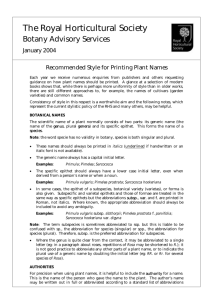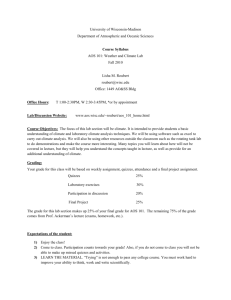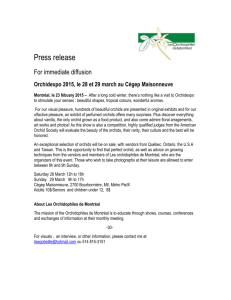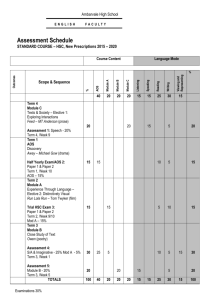American Orchid Society Heritage Plant Auction Catalog
advertisement
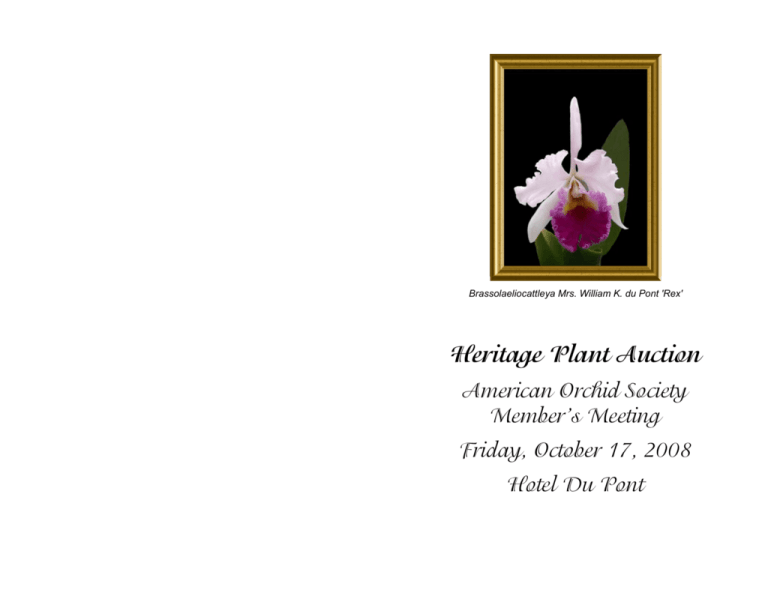
Brassolaeliocattleya Mrs. William K. du Pont 'Rex' Heritage Plant Auction American Orchid Society Member’s Meeting Friday, October 17, 2008 Hotel Du Pont Benefactors Dr. Alan Bachrach Helina Mendez Jeff Bradley Fred Missbach Dr. Judy Cook Andrea Neissen Steven Cristoffersen Peter Nguyen Keith Davis Walter and David Off (Waldor Orchids) Glen Decker (Piping Rock Orchids) Norman Fang (Norman’s Orchids) Carlos Fighetti Frank Fordyce Robert Fuchs Mike Coronado (R. F. Orchids) Dr. Wilton Guillory Hiroshi Okada (Okada Orchid Nursery) Tom Perlite (Golden Gate Orchids) Santa Barbara Orchid Estates Seagrove Orchids Joseph and Anthony Silva (Silva Brothers Orchids) Courtney Hackney Frank Smith (Krull-Smith) Norito Hasegawa David Toyoshima Carter and Holmes Linda Thorne (Seagrove Orchids) Patti Powell James Longwood Gardens Cesar Wenzel (Wenzel Orchids) Joan Lines MacCandless (Lines Orchids) Mark Werther Plato Mathews Reggie Wright All proceeds designated for the “American Heritage Collection Fund” Friday, October 17, 2008 Hotel Du Pont - Wilmington, Delaware Absentee bids will be accepted for the auction under the following rules: ■ Deadline for absentee bids placed via the AOS Web site is Wednesday, October 15th, 5:00 p.m. ET. ■ Payment accepted: MasterCard, Visa, American Express. Must provide credit card information in advance to guarantee payment. (Sorry, no debit cards or checks accepted). All payments in US DOLLARS. ■ Shipping: Plants will be shipped with shipping and handling charges to be paid by Bidder. ■ Winners will be notified of they plants they won and final bid amounts by telephone no later than October 22, 2008. ■ Send bids to Susan Wayman at swayman@aos.org before the close of business on October 15, 2008. Questions? call 561-404-2031 Pierre S. duPont Alice B. duPont Mrs. W. K. duPont Forward On May 15, 1946, Pierre S. du Pont, his wife Alice Belen, and his sisterin-law, Mrs. William K. du Pont, hosted the twenty-fifth annual meeting of the American Orchid Society at Longwood Gardens. The event was the largest gathering of members of the orchid community up until that time, with 934 persons present. Rodney Wilcox Jones, AOS President at that time, called the meeting to order and stated: “Longwood—you cannot speak the name without a picture coming before your eyes.” The event made a great impact upon the attendees, so much so, that it was talked about for decades throughout the orchid circles of the world. After sixty-two years, the American Orchid Society is truly honored once again to be a guest of Longwood Gardens and the du Pont family with our Trustees/Members meeting being held at this magnificent venue. The auction tonight is also a historic one. During the long life of the American Orchid Society, never has there been such a collection of rare and historic plants for sale, nor has there been such generosity shown with donations of these costly treasures by so many benefactors. I would like to thank all of those who have provided the plants for tonight’s event. The Heritage Plant Auction is dedicated to the memory of Pierre S. du Pont, Alice B. du Pont, and Mrs. William K. du Pont, all of whom were charter members of the American Orchid Society, and who gave so much of their time, expertise, and funds, to the organization that we all enjoy today. All proceeds will go to the Heritage Plant Collection Fund of the American Orchid Society, which will ensure the preservation of historically important cultivars for those orchid students of today and those of tomorrow. Publisher - Jeff H. Bradley Editor and Formatting - Joe Dietz American Orchid Society Heritage Plant Auction Lo t 1 Lc. Adolph Hecker ‘Lynn’, AM/AOS, 1968, (C. Porcia x Lc. Bonanza) Hecker, 1959 A rare and desirable plant with shapely, glowing purple flowers and a diamond-dust texture. This cattleya that made quite a splash in the late 1960’s and was a tribute to the growing abilities of Hobbie Hawkins of Palm Beach, Florida. 2 C. Alice B. du Pont (C. Sunrise Chalet x C. Louise Georgianna) Off and Sons, 2006 Waldor Orchids of Linwood, New Jersey, named this grex for the wife of Pierre S. du Pont in 2006. This magnificent white cattleya has terrific substance and is a prolific bloomer. 3 Blc. Amy Wakasugi ‘Ester Miles’, AM/AOS, 1968, (Lc. Bonanza x Blc. Herons Ghyll) Wakasugi, 1966 Most collectors consider this cultivar to be the best of the grex. The 7” flowers with an intense red lavender, with an extremely heavily ruffled ruby lip. Billy Miles of Maitland, Florida, named this cultivar after his wife. Lc. Areca ‘Model’, FCC/AOS, 1958, (Lc. General Maude x C. Enid) Stuart Low, 1922 4 A magnificent dark lavender cattleya with form and shape comparable to today’s standards. The intensity of yellow veining in the throat on a very dark magenta lip is truly something to behold. This cultivar was one of the “treasures” of B. O. Bracey’s collection in Santa Ana, California. It was very tightly held and remains so to this day. It is very rare and is extant in only a very few private collections. 5 Image not available Lc. Arid Acres ‘Tinsel’ (Lc. Mamie Eisenhower x C. Chickamauga) Blue Grass Orchids, 1962 This magnificent lavender cattleya was once an important cultivar in the cut flowers market. It blooms freely in the winter and has slight flares. 6 Slc. Anzac ‘Orchidhurst’, FCC/RHS, 1938, (Slc. Marathon x Lc. Dominiana) Charlesworth, 1921 This famous red cattleya breeder came to America through Clint McDade of Rivermont Orchids and his purchase of the Armstrong and Brown Collection. It is impossible to study the breeding of red cattleyas in America or abroad without focusing upon Laurie Humphries (of Armstrong and Brown) famous remake of the original cross made by Charlesworth using the “Orchidhurst” cultivar of Slc. Marathon. 7 Image not available C. Athena Chagaris ‘Orchidhaven’ (C. Helen P. Dane x C. Barbara Billingsley) Patterson, 1965 Harold Patterson’s famous white cattleya, which he used extensively in his breeding program. C. Athena Chagaris is a prolific bloomer and was a very important hybrid in Patterson’s cut flower production. 8 Cym. Babylon ‘Castle Hill’, FCC/RHS, (Cym. Olympus x Cym. Pauwelsii) H. G. Alexander, 1942 Few cymbidiums have ever attained such an exalted status in the world of hybridizing, as has ‘Castle Hill.’ This tetraploid has produced some of the finest offspring of the entire cymbidium world. No cymbidium collection either past or present would be complete without this truly rare and coveted plant and was one of H. G. Alexander’s personal triumphs in breeding. (Reserve Bid) 9 Cym. Balkis ‘Silver Orb’ AM/AOS, 1953, (Cymb. Alexanderi ‘Westonbirt’ x Cymb. Rosanna ‘Pinkie) Lionel de Rothschild, 1932 This cultivar changed the face of post World War II, cymbidium breeding forever. Stewart Orchids obtained this plant from Burt Cobb who brought it in from Europe. This cultivar was originally known as cross C-7000. Ernest Hetherington, made this cultivar famous throughout the world and used it countless times in his cymbidium breeding program at Stewart Orchids. 10 C. Bob Betts ‘The Virgin’, FCC/AOS, 1960, (‘Rivermont’ x ‘52’) A sib cross between two Bob Betts that produced one of the three best C. Bob Betts cultivars. Cattleya Bob Betts was named after the celebrated grower and hybridizer who Clint McDade of Rivermont Orchids hired away from a private collector. Although George Cutler of San Francisco, California, exhibited the plant for its award, the sibing was made at Rivermont between C. Bob Betts ‘Rivermont’ and C. Bob Betts ‘#52’. This cultivar, remains, a standard of excellence in white cattleyas, and is a must for any serious collector. 11 Blc. Bouton D’Or ‘Lewis’, AM/AOS, 1973, (C. Wolteriana x Blc. Buttercup) Sowell 1968 Intense apricot flowers with flush of mauve on edges of petals and a fantastic breeder. The translation from the French, “Golden Button” is an apt description of the flowers, but it does not do justice to the intensity of this color. 12 C. Bow Bells ‘Lorena Gore’, FCC/AOS, 1948, (C. Edithae alba, ‘White Empress’ x C. Suzanne Hye,, alba) Black and Florey, 1945 No single cattleya had such and impact on the cut flower market after World War II than did C. Bow Bells, named after the famous London church, St. Mary le Bow. Up until 1946, only a handful of white cattleyas had any substance to speak of, much less a desirable shape. However, C. Bow Bells changed this forever. This particular cultivar was Gov. R. H. Gore’s finest white cattleya and one of the two best Bow Bells to be awarded. This is an original division from the collection of Alfred J. Proebstle and was a gift from R. H. Gore. 13 Blc. Buttercup ‘Perfection’, HCC/AOS, 1971, (Blc. Primate x Blc. Golden Myth) Rivermont, 1961 Butter yellow flowers with reddish suffusion through the labellum and a wonderful breeder. Odie Helton made this grex during his tenure at Rivermont Orchids. It is a prolific bloomer and a showstopper! 14 Paph. Bruno ‘Model’, AM/RHS, 1952, AM/AOS, 1981 (P. Leeanum x P. spicerianum) Veitch, 1896 A truly wonderful historic paph and a must for any serious collector. 15 C. Catherine Patterson ‘Shore Orchid Growers’ (C. Enid x C. Mrs. Frederick Knollys) Patterson, 1952 Undoubtedly the best cultivar of Patterson’s famous grex, this plant has always been a showstopper at the New York Show. This magnificent semi-alba produces massive heads of flowers that seem to last forever. The owners of this cultivar can not say for certain that this is Harold J. Patterson’s famous cultivar ‘Orchidhaven,’ This particular plant was part of the cut flower production at Shore Orchids (thus the reason for the name). However, it would appear that this cultivar is one and the same as the ‘Orchidhaven’ clone, and would also explain the exceptionally fine qualities of the flowers. 16 Slc. Circle of Life ‘New Ace’, AM/AOS, 2004, (Lc. Culminant ‘La Tuilerie’ x S. coccinea 4n) Fordyce, 1998 A division of one of Frank Fordyce’s hybridizing triumphs that is certain to be a part of the breeding of compact cattleyas for years to come. 17 Slc. Circle of Life ‘Red Halo’ AM/AOS, 2006 Another cultivar of the same grex, and most certainly is another tribute to the breeding skill of Frank Fordyce. 18 Bc. Cliftonii ‘Magnifica’, FCC/RHS, 1909 & 1913, AM/AOS, 1940 & 1955, (Bc. Digbyanomossiae x C. trianaei) Charlesworth, 1908 This plant was a standard of excellence in purple cattleyas prior to World War I, and remained so for many years. Its history in America is older than the American Orchid Society itself, as Albert Cameron Burrage purchased the plant for his private collection in 1912, from F. M. Ogilvie, shortly after it was awarded by the RHS. By the early 1930’s this cultivar was part of the Dixon, W. K. du Pont and Clement Moore collections as well. Although it cannot be compared to the hybrids that appeared after World War II, this beautiful medium lavender cattleya with 8” flowers and large ruffled magenta lip has maintained a role in the serious collections for many years. 19 Phal. Cordova ‘Orchidphile’, AM/AOS, 1992, (Phal. Golden Buddha x Phal. Zuma Garnet) Zuma Canyon, 1980 Truly one of the most outstanding red phalaenopsis in the world and a fantastic breeder. This is the best clone of the cross made by Amado Vazquez at Zuma Canyon. 20 Lc. Culminant ‘La Tuilerie’, AM/AOS, 2007, AM/RHS, GM/WOC, (Lc. Isle de France x Lc. Gaillard) Vacherot and Lecoufle, 1957 21 Ascocentrum, curvifolium f., luteum ‘R. F. Orchids’, CHM/AOS, 1983, AM/AOS, 1989 Beautiful bright, clear yellow flowers on tall inflorescences. This is an extremely rare color form of the species. A division of the original awarded plant from northern Thailand brought to the U.S. in the early 1980’s by Robert Fuchs. 22 Bc. Deesse ‘French Lace’, AM/AOS, 1964, (Bc. Ferrieres x C. Lamartine) Vacherot and Lecoufle. 1947 The grex Bc. Deese was registered by the venerable French firm of Vacherot and Lecoufle in 1947, and was one of the first fine post World War II brassos to produce large flowers with excellent form and substance. There were many cultivars to come out of this cross, and some have better overall form than ‘French Lace,’ nevertheless, none can surpass its exquisite wide and heavily ruffled brasso lip. This is an original division from the mother plant belonging to Vacherot and Lecoufle. 23 Lc. De Loris Ziegfeld ‘Snowbird’, AM/AOS, 1961, (Lc. Princess Margaret ‘#2’ x C. R. Cadwalader ‘Lager’s) Patterson, 1941 When Haydn Sparks of Miami, Florida, first exhibited this splendid semi-alba form of Harold J. Patterson’s cross in 1957, the plant was only awarded an HCC. However, in 1961, former AOS President, Bill Farrell, of Bremerton, Washington, was able to have the award elevated to an AM. The chalky white flower with an intense purple lip and soft yellow eyes was the only cultivar of this grex to be a semi-alba. Laeliocattleya De Loris Ziegfeld ‘Snowbird’ was considered to be a standard of excellence in semi-alba cattleyas for many years, not to mention the manner in which it stands out in any collection due to the sharp contrast between the intensely white petals and the deeply colored lip. 24 C. Dubiosa ‘Perfection’, AM/AOS, 1963, (C. harrisoniana x C. trianaei) Maron, 1890 These four and one-half inch waxy flowers were one of many hits coming out of the celebrated Florida orchid firm of Jones and Scully. 25 C. Earl ‘Imperialis’ FCC/AOS, 1980, (C. Empress Bells x C. General Patton) Suyara, 1961 Another famous white FCC from the early 1960’s, and a must for any historic collection. 26 Bulb. Elizabeth Ann ‘Buckleberry’, FCC/AOS, 2006, (Bulb. longissimum x Bulb. rothschildianum) Chambers, 1969 This plant which originally came from Stewart Orchids, received an AM first when exhibited by Rita Cohen and later, Dr. Judy Cook took it to a new level with both an FCC and a CCE. It is certainly a must for any serious bublbophyllum collector. 27 C. Enid coerulea ‘Blue Lou’ (C. mossiae x C. warscewiczii) The famous figure skater and orchid grower Jerry Rayfield considered this cultivar to be the finest coerulea form of C. Enid. This plant is indeed a very rare treasure and can be found in only a handful of private collections. It is a must, for a collector of blue flowered orchids. 28 Phal. equestris ‘Royal Ruby’, FCC/AOS, 1993 This cultivar is truly one of the finest equestris in the world and a hallmark in the collection of Carlos Fighetti. This is the first of two phalaenopsis equestris to receive an FCC by the AOS. It was made by Herb Hager at the Orchid Zone by a sib cross between two very dark clones of equestris. This is a keiki of the original plant. Any phalaenopsis collection of merit should have this closely held plant. 29 Blc. Ermine ‘Lines’. AM/AOS, 1952, (Blc. Aurea x C. Amabalis) Flandria, 1935 This is the famous butterscotch yellow flower that John Lines made famous across the world. These mid-size flowers produce a magnificent display. Ermine ‘Lines’ is truly one of the best of the early attempts at breeding yellow cattleyas and is still highly regarded and a rare treasure in collections today. 30 Lc. Eva Robinson ‘Ingham’, FCC/AOS, 1950, (Lc. Ishtar x C. Angus) Black and Florey 1943 Mable Ingham of Haddam, Connecticut, made this immense 9” flower famous both in America and abroad when she received an FCC of 93 points in June of 1950. The deep rosy mauve petals are accented with a distinctive dark splash at the tips of the petals. The flowers are so large and splashing that the plant became highly coveted throughout the orchid world. Maurice Lecoufle once commented that Lc. Eva Robinson ‘Ingham’ was one of the most popular of the plants he cloned, as it was not widely held in private collections. Only a very small number of private collectors still hold the plant in their collections. 31 Slc. Falcon ‘Westonbirt’, FCC/AOS, 1964, FCC/RHS, 1922, (Lc. Aureole x S. coccinea) Holford, 1917 Few plants in the history of orchid hybridization have been so coveted as Slc. Falcon ‘Westonbirt’ and it’s sister cultivar, ‘Alexanderi.’ Sir George Holford’s celebrated grower, H. G. Alexander, made this cross which produced two cultivars whose color was truly cardinal red. In the many years of breeding since “the Falcons” arrived, no one has produced a cross of finer and clearer true red. In the 1950’s “the Falcons” were demanding $750.00 per bulb. The ‘Westonbirt’ clone has the best form, and only a handful of growers can boast of having this cultivar in their collection. Although countless attempts were made in breeding with “The Falcons,’ however, it proved to be a difficult breeder. Nevertheless, the color and the historical merit of this cultivar is unsurpassed by few other orchids. 32 Cym. Featherhill ‘Heritage’, AM/RHS, AM/AOS, 1964, (Cym. Spartan Queen x Cym. Babylon ‘Castle Hill’) Mary B. Ireland, 1956 Cymbidium Featherhill ‘Heritage’ was one of the very important post World War II, American hybrids. The cross was registered by the famous cymbidium grower, Mary B, and it was one the “American” triumphs in breeding. 33 C. Fitz Eugene Dixon, AM/AOS, 1932, (C. Portia x C. walkeriana) Dixon, 1922 This is a division from the original Dixon plant and produces massive numbers of bright purple flowers on upright stems. This plant was purchased from F. E. Dixon by the famous collector, Alfred J. Proebstle of Brazoria, Texas. It was one of the best multi-flora cattleyas prior to World War II. 34 Blc. Fortune ‘Golden Throne’, HCC/AOS, 1966, (Blc. Xanthette ‘Chartreuse’ x Lc. Mem. Albert Heinecke ‘Sutter’s Fort’) Stewart, 1963 Ernest Hetherington’s famous cross that changed the face of yellow cattleya breeding. Prior to Blc. Fortune, there were few clear yellow flowers that did not deform or fade, however, Fortune did neither. The improvement in yellow brassocattleyas with this grex was substantial. Although there were many cultivars from this grex to receive acclaim, ‘Golden Throne’ was and still is considered by Ernest to be the best of the best. This cultivar was used extensively in his breeding program at Stewart Orchids and is one of the parents of Blc. Goldenzelle. 35 C. gigas ‘Bedford’ This cultivar produces large semi-alba flowers of excellent form and substance. ‘Bedford’ was discovered much later than ‘FMB,’ however; some collectors today consider this cultivar to be far superior to its more famous sister. It is highly coveted by serious collectors today and commands a great price when one can find a division for sale.. 36 C. gigas ‘Frau Melanie Beyrodt’ FCC/RHS, 1904 One of the two finest semi-alba forms of C gigas ever found in the jungles of Columbia. Long before this cultivar appeared in private collections in America, it was a treasured plant in Europe. The celebrated orchid hybridizers, Harold J. Patterson of H. Patterson and Sons, and B. O. Bracey of Armacost and Royston, made this cultivar famous as a result of their extensive use of this plant in their breeding programs to produce semi-alba summer bloomers. Cattleya gigas ‘FMB’ for short has always been considered to be a necessary part of any serious collection of cattleya species. 37 C. gigas ‘Marjorie’ This cultivar is a fine semi-alba form from Christoffersen’s collection named after his mother. Steven collects only the best and this is a division of the original plant, which can be found in only a couple of private collections!! 38 C. Granier’s Pride ‘Patty’, AM/AOS, 2004, (C. Minerva x C. walkeriana) Granier, 2002 One of Ervin Grainer’s many celebrated cultivars. The flowers have lavender sepals and petals and, a trilobed, ruffled lip. There is a faint amethyst picotee on the side lobes of the very full lip. The flowers have a sparkling texture. 39 Lc. H. G. Alexander, FCC/RHS, 1942, (Lc. Moloch var. majestic x Lc. Momus) Alexander, 1942 Eight inch clear mauve flowers that are as good today as they were in 1942, and a very rare treasure from the past. The intense purple of the sepals and petals is matched only by the velvety texture of the lip with an intense, creamy white “blotch” on either side of the lobe. The Master of cattleya breeding thought so much of this cross that he named it after himself. To quote the “Orchid Review” of 1942, “this new hybrid is undoubtedly one of the very finest of the many Laeliocattleyas…in every respect this is a very fine orchid and worthy of the name it bears.” This plant is truly rare and exists only in a handful of private collections today! 40 Paph. Harrisianum, FCC/RHS, (Paph. barbatum x Paph. villosum) Veitch, 1869 This is the first paphiopedilum hybrid ever made and this cultivar is a division of the plant originally awarded by the RHS so long ago. For the historical collector, this cultivar is a must! 41 Slc. Hazel Boyd ‘Orchid Alley’s Lipstick’, AM/AOS, 1983, (Slc. California Apricot ‘Orange Circle’ x Slc. Jewel Box ‘Beverly’) McLellan, 1975 One of the first exceptionally fine mini-catts to be introduced to the orchid market; a cross made by Frank Fordyce during his tenure at McLellan. 42 Slc. Hazel Boyd ‘Orchid Alley’s Tangerine’, AM/AOS, 1985 Another fine cultivar of this grex! 43 44 Paph. Hellas ‘Sunset’, HCC/AOS, 1985, (Paph. Desdemona x Paph. Tania) H. G. Alexander, 1940 A magnificent golden orange flower that is far superior to the ‘Westonbirt’ clone. Phal. Henriette Lecoufle ‘Boule de Neige’, FCC/RHS, 1969, (Phal. Lachesis x Phal. Ramona) Vacherot and Lecoufle, 1967 Vacherot and Lecoufle’s famous white breeding plant that won it’s award with 100 flowers on branch stems. It has been tightly held for years. This cultivar passes it “branching” quality to its offspring as well as its exceptional shape and substance. Very few outside the Lecoufle family have ever owned this plant! 45 46 47 Blc. Herons Ghyll ‘Nigrescens’, AM/AOS, 1961, AM/RHS, 1960, (Blc. Norman’s Bay ‘Low’ x Lc. Ishtar ‘Low’) Low, 1955 A famous cross made by Stuart Low and Co. crossing Norman’s Bay with one of its parents. The petals and sepals of the flowers are an intense rosemagenta with a very deep royal purple lip. This cultivar, exhibited by Bill Richardson of Bal Harbour, Florida, became an instant collector’s item across the country. C. Horace ‘Maxima’, AM/AOS, 1966, (C. trianaei ‘Rex’ x C. Woltersiana) Flandria, 1938 This is a division of THE original plant that came from Flandria in Belgium. Although Flandria registered C. Horace in 1938, it never gleaned any RHS awards, probably due to the fact that a large portion of Flandria’s collection was sent to America during World War II for safekeeping. This magnificent and historic breeder became synonymous with the phrase “overlapping petals,” a rarity in those days. C. Horace ‘Maximum’ a synonym of ‘Maxima,’ was first awarded an HCC in 1963, and was shone by Hugo Freed, of Arthur Freed Orchids, of Malibu, California. Three years later in 1966, the Westenberger Orchid Company of San Fernando, California received an AM on this cultivar. The first known record of this plant in the United States appears in the collection of Joseph Urmston. This division is exceedingly rare as it has a proven provenance coming directly from Flandria. Paph. Huddle ‘Georgetown’, AM/AOS, 1976, (Paph. Hellas x Paph. F. C. Puddle) Greendyke, 1963 A highly collectible complex white paphiopedilum. From the collection of Merritt Huntington of Kensington Orchids. 48 C. intermedia var. alba ‘Stephen’s Pride’, FCC/AOS, 2001 This is a division of Dr. Wilton Guillory’s famous FCC plant that he has never released. This cultivar represents the finest alba form of the species ever to be awarded by the AOS. ‘Stephen’s Pride’ has raised the bar for all future forms of C. intermedia. 49 Phrag. Jason Fischer ‘Suzanne’, AM/AOS, 1998, (Phrag. Mem. Dick Clements x Phrag. besseae) Orchids Ltd., 1996 Winner of the W. W. Wilson award in 1998, and the first division of this highly coveted plant ever to be released. 50 51 Slc. Jewel Box ‘Beverly’, AM/AOS, 1970, (C. aurantiaca x Slc. Anzac ‘Orchidhurst’) Stewart Orchids, 1962 This is the rarest and most desirable of all of the cultivars and proven to be the best breeder. This is an original division from the collection of the beer heir, Rudy Pabst. This plant was named for his wife Beverly Shlitz, also of beer fame. Ernest Hetherington made this magnificent cross and its fame surpassed that of all of the red cattleyas of the day. A truly historic plant in the world of red cattleya breeding! C. Joyce Hannington ‘Shore Orchid Growers’ (C. Barbara Dane x C. Snowdon) Dane, 1945 This plant is most probably the cultivar ‘September Morn,’ however; it was an important flower in the cut flower production of the famous Shore Orchids in New Jersey. Both C. Joyce Hannington and C. Bow Bells were registered at the end of the war in 1946 and there has always been controversy as to whether the two grexes were the same thing. Joyce Hannington was the wife of the celebrated grower for the Dane Estate and this grex along with C. Bow Bells, changed the face of modern-day white cattleya breeding forever. 52 Cym. Jungfrau ‘Dos Pueblos’, AM/AOS, 1958, (Cym. Alexanderi x Cym. Eagle) H. G. Alexander, 1933 This cultivar was from the remake of Cymbidium Jungfrau, which Sam Moser of Dos Pueblos made. The ‘Dos Pueblos’ clone was far superior to the famous FCC/RHS clone known as ‘White Empress’. This cultivar was one of the finest white cymbidiums available in the 1950’s and a must for any collector. 53 C. labiata ‘Cooksoniae’, FCC/RHS, 1895 This is one of the two most famous of the semi-alba cultivars of Cattleya labiata. This cultivar was awarded its FCC by the RHS in 1895, to Mr. Cookson, a year before C. labiata Mrs. E. Ashworth. The plant produces a magnificent display of very erect flowers and is most certainly a must for the serious collector. 54 Paraphalaenopsis labukensis ‘Haley Suzanne’ AM/AOS, 1993 This plant has never been cloned and this is the original awarded plant! 55 Lc. Lee Langford ‘Copper Queen’, HCC/ODC, 1958, (Lc. Calizona x Lc. S. J. Bracey) Ozella, 1948 Of all of the early art shade cattleyas that appeared after World War II, few could compare with the color and shape of Lc. Lee Langford. This cultivar has been used countless times in breeding programs and is a very rare treasure indeed. There are very few plants of this cultivar in private collections today. When one does appear for sale, the price that this cultivar commands is great. The late Murray Spencer of breeding fame considered ‘Copper Queen’ to be a major breakthrough in the breeding of art shade cattleyas. 56 Cym. Lillian Stewart ‘Coronation’, FCC/RHS, AM/AOS, 1984, (Cym. Balkis ‘Silver Orb’ x Cym. Carisona) Stewart Orchids, 1955 Ernest Hetherington has been revered throughout the orchid world for his many successes in breeding, but none are more celebrated than the worldwide sensation he achieved with Cymbidium Lillian Stewart. This grex was named after the wife of Fred A. Stewart, the owner of the company. This cross produced over sixty awards, but none of the cultivars are more highly coveted than ‘Coronation.’ It is the opinion of many cymbidium growers that Cymbidium Lillian Stewart ‘Coronation’ remains the finest pink cymbidium in the world; even to the present day. 57 C. loddigesii var. coerulea ‘Blue Sky’, AM/AOS, 1987 Perhaps the finest coerulea form of the species that is a prolific bloomer and a plant coveted by collectors. 58 C. loddigesii var. harrisoniana ‘Streeter’s Choice’, FCC/AOS, 1988 Almost every serious orchid grower recognizes this famous cultivar. The cultivar, ‘Streeter’s Choice’ is undoubtedly the finest and largest form of the species. Dr. Streeter and H&R Nursery cloned only 100 meristems of this plant in the 1980’s, which were offered for sale at a cost of $250.00 per plant. This is one of those mature meristems. 59 C. Louise Georgianna ‘Phillippe’ (C. intermedia x C. Souvenir de Louis Sanders) Kiesewietter, 1946 Although this cultivar was never awarded, Maurice Lecoufle of Vacherot and Lecoufle thought it to be the best of the cultivars, and as a result, he named it after his son. This grex was one of two crosses that popularized the “cocktail-size cattleya.” Ralph Kiesewetter named this plant for his daughter Louise, who is with us tonight at this auction. 60 Lc. Lustre ‘Westonbirt’, FCC/RHS, 1928, (Lc. Callistoglossa ‘Holford’s’ x C. lueddemanniana ‘Fine’) Holford, 1907 Throughout the history of orchid breeding, no singular plant has had such an impact as has Lc. Lustre ‘Westonbirt’. Over 700 hybrids today have Lustre in its background. This is unquestionably the rarest plant in the auction and is held in only FIVE private collections in the world. When B. O. Bracey left the employment of H. G. Alexander in the early 1920s to come to America and work for Walter Armacost, Bracey quickly “educated” Mr. Armacost as to the finest plants in Europe. However, above all the plants grown in collections in Europe, none made such an impression upon Bracey as did Lc. Lustre “Westonbirt.” As a consequence, he convinced his new employer to purchase “at a king’s ransom,” a division of this plant from Alexander, and Bracey quickly began to breed with the plant. There are very few fine purple cattleyas in existence today that do not have this specific cultivar in their background. In the entire history of the orchid culture in America, there were only eight collections, both commercial or private who owned this plant, and the last remaining plant was that belonging to Alfred J. Proebstle of Brazoria, Texas, from which this backbulb division comes from. Unless my count is incorrect, I don’t believe it to be, this small division represents only one of five remaining pieces of the incomparable Lc. Lustre ‘Westonbirt’ remaining in the world. (Reserve Bid) 61 Bc. Madame Charles Maron, FCC/RHS, 1902. (B. digbyana x C. gigas) Maron, 1901 Undoubtedly one of the top five treasures of this auction. This plant is an original division from the famous Fitz Eugene Dixon and Eleanor Weidner Dixon Collection of Elkins Park, Pennsylvania. The plant passed from the Dixon Collection to the private collection of Oliver Lines and his son, John Lines of Signal Mountain, Tennessee. There are none others in existence. (Reserve Bid) 62 Paph. Maudiae ‘Los Osos’, AM/AOS, 1984, (Paph. callosum x Paph. lawrenceanum) Charlesworth, 1900 This cultivar remains even today a top breeder. It is a division of the original plant that belonged to the late collector of orchid fame, Norris Powell. 63 Blc. Memoria Crispin Rosales ‘Kensington’ (Lc. Bonanza ‘Gaity’ x Blc. Normans Bay ‘Royal Bride’) Bracey (1959) One more of B. O. Bracey’s triumphs in breeding. This became a standard in purple cattleyas from the 1950’s into the 1970’s and this particular cultivar was part of the collection of Dr. Edgar McPeak and Merritt Huntington of Kensington Orchids. 64 Blc. Memoria Helen Brown ‘Sweet Afton’, AM/AOS, 1976, AM/RHS, 1983, (Blc. Xanthette ‘Chartreuse’ x Lc. Ann Follis ‘Goldilocks’) Stewart, 1967 The best green Brassolaeliocattleya that Ernest Hetherington ever made during his tenure at Stewart Orchids. ‘Sweet Afton’ is most certainly one of the two best of this cross and is especially known in orchid circles as the best breeder. 65 Blc. Memoria Ralph Palcentia ‘Toreador’, AM/AOS, 1990, AM/RHS, 2001, (Lc. Mem. Albert Heinicke ‘Sutter’s Fort’ x Blc. Norman’s Bay ‘Gothic’) Stewart, 1973 Another one of Ernest Hetherington’s triumphs in cattleya breeding during his long tenure at Stewart Orchids. The intensity and richness of the color coupled with a wonderful shape, make this cultivar a must for any collector. When Fred A. Stewart Orchids first released the plant, the asking price was $600.00 for a 4” pot. 66 Paph. Michael Koopowitz AM/AOS (Paph. philippinese x Paph. sanderianium) Paphanetics, 1993 One needs only to list the credits of this truly spectacular cultivar and nothing else is required: Grand Champion of the 19th WOC, Gold Medal of the 19th WOC, Best in Show at the 19th WOC, Best in Class at the 19th WOC. (Reserve Bid) 67 Lc. Molly Tyler FCC/AOS, 1937, (Lc. Mrs. W. N. Elkins x C. Leda) F. E. Dixon 1930 Truly a classic of the bi-foliates prior to World War II. However, this cultivar simply known as “FCC” has held its place for many decades. The plant produces massive heads of crystalline purple flowers that never cease to amaze the grower. It is simply a must for a classic cattleya collection. It was the pride and joy of Fitz Eugene Dixon and one of the first plants he presented to Pierre du Pont’s Longwood Gardens. 68 Bc. Mrs. J. Leeman ‘Low’ (B. digbyana x C. dowiana) Marion, 1902 An extremely rare early yellow breeder that up until 1945 had 130 hybrids registered using this plant as a parent. This primary hybrid has been written about countless times throughout the years. This fabulous lip is legendary and the fragrance is unsurpassed. This was a favorite plant of Mrs. William K. du Pont and was photographed extensively in black and white. This cultivar was very closely held by Stuart Low. All remaining divisions of this plant (which are only a handful) are successions from the either the Burrage, William K. du Pont, or Dixon Collections. A truly historical plant indeed. (Reserve Bid) 69 Blc. Mrs. William K. du Pont ‘Rex’ (Blc. Imperialis ‘Westport’ x Lc. Elizabeth Off ‘Sparkling Burgundy’) Off and Sons, 2007 This plant is featured on the cover of this catalogue and was registered in 2007 by Off and Sons of Linwood, New Jersey in honor of Mrs. William K. du Pont. One of the five plants was presented to Longwood Gardens last year. Only one other division of this cultivar is in private hands 70 Brassavola nodosa ‘Susan Fuchs’, FCC/AOS, 1973 The finest nodosa ever awarded by the AOS. This cultivar produces extremely large apple-green flowers with a brilliant, pure white lip. This is a division of the original awarded plant, collected by Robert Fuchs near Rivas, Nicaragua in the 1960’s. 71 Blc. Norman’s Bay ‘Gothic’, AM/AOS, 1960, AM/RHS, 1953, (Bc. Hartland ‘Low’ x Lc. Ishtar ‘Low’) Stuart Low, 1946 Of all of the Norman’s Bay cultivars from the original English swarm, this plant has the darkest color. With the exception of the ‘Low” cultivar, none have been used as extensively in breeding than ‘Gothic’. A must for any collector. 72 Blc. Norman’s Bay ‘Low’, FCC/AOS, 1976, FCC/RHS, 1952, (Bc. Hartland ‘Low’ x Lc. Ishtar ‘Low’) Stuart Low, 1946 Without question, this cultivar is the most famous of the Norman’s Bay original swarm and the undisputed best flower, both in shape and substance, as well as overall form. ‘Lows” variety has been used countless times by breeders throughout the world. When it first became available after the Second World War, Miss Eileen Low was asking, and getting $750.00 per bulb. 73 Blc. Norman’s Bay ‘Lucile’, FCC/AOS, 1964, (Bc. Hartland ‘Low’ x Lc. Ishtar ‘Low’) Stuart Low, 1946 Of all of the cultivars of Blc. Norman’s Bay ‘Lucile’ has been admired for the exceptionally electric color of the flowers and their substance. When Haydn Sparks first exhibited the plant in New York in 1957 and received an AM/AOS, the judges’ remarks were focused upon the color and exceptional substance. 74 Dtps. Olympic Gold ‘FANGtastic’, AM/AOS, 2008 (Dtps. Autumn Sun x Dtps. Bronze Idol) Orchid Zone 1999 This perfectly round and flat flower with clear golden and non-fading yellow that intensifies in color as the flower matures. The cross was the legacy of Herb Hager at the Orchid Zone. This cultivar was recently awarded to Carlos Fighetti, and this plant is the one that was awarded. 75 Paph. Orchilla ‘Chilton’, FCC/AOS, 1973, (Paph. Paeony x Paph. Redstart) Ratcliffe, 1962 A solid red breeder from the distinguished Ratcliffe Collection and a must for a serious breeding program. 76 Mclna. Pagan Lovesong ‘Sheila’, FCC/AOS, 1984, (Odcdm. Tiger Butter x Brs. verrucosa) McLellan, 1978 This cultivar is the finest in a hybrid where there were over fifty awarded varieties. The grex was a groundbreaking hybrid between an Odontocidum and Brassia where the seedlings all exceeded the parentage in both flower quality and vigor of growth. This particular variety will grow well under warm or cool conditions, producing a 4-5 foot branched inflorescence with 5” flowers. 77 Blc. Pamela Hetherington ‘Coronation’, FCC/AOS, 1981, (Lc. Paradisio ‘Colossal’ x Bc. Mt. Anderson ‘Very Fine’) Stewart, 1970 A true masterpiece in Ernest Hetherington’s breeding program during his tenure at Stewart Orchids. This magnificent pink brasso was of such quality that Ernest named the grex after his daughter, Pamala who is with us tonight. 78 Blc. Ranger Six ‘A-OK’, FCC/AOS, 1980, (Blc. Nacouchee ‘Fantasia’ x C. Empress Bells ‘Stephenson’) Armacost, 1964 A truly exceptional white brasso known for the intensity of the golden yellow in the lip. This cultivar raised the bar in white cattleya breeding. It is a tribute to the many accomplishments in breeding by Leo Holguin during his tenure at Armacost and Royston. 79 Paph. rothschildianum ‘Jim Krull’, FCC/AOS, 2006 Yet another triumph of Krull-Smith. This giant flower was awarded an FCC in 2006, at an AOS trustees meeting. It is truly in a class of it’s own. This is a rare opportunity to own this magnificent cultivar. (Reserve Bid) 80 Paph. sangii A flowering size division of a very rare species. 81 C. skinneri ‘Carpenteria’, FCC/AOS, 1993 This cultivar was one of Stewart Orchid’s best species with exceptional color and form. This is a division of the original mother plant, not a meristem. 82 C. skinneri ‘Casa Luna’, AM/AOS, 1993 This cultivar was originally collected in the late 1940’s and was part of the Hewlett Collection of New Jersey. Gene Crocker of Carter and Holmes, believes this original division to be the best C. skinneri ever found. 83 Paph. Stagecoach ‘Wheatfields’, HCC/AOS, 1978, (Paph. Sandra Mary x Paph. Kay Renamon) Rod McLellan, 1976 A very unusual tri-color complex hybrid from the McLellan Company 84 Vanda tessellata ‘R. F. Orchids’, AM/AOS, 1986 Exceptional rich caramel-colored flowers with a bright lavender lip. Very fragrant, with heavy substance and satin texture. Given to Robert Fuchs by Thonglor Rakpaibulsombat, founder of T Orchids in Bangkok as a first-bloom seeding. A division of the original awarded plant. 85 Bc. The Globe ‘Bracey’s’, AM/RHS, 1924, (Bc. Cliftonii ‘Magnifica’ x C. trianaei ‘The Baron’) Armstrong and Brown 1924 This is a division of B. O. Bracey’s original division of this most famous and exceedingly rare breeder. This plant was part of the collection of the celebrated orchid grower, Alfred J. Proebstle who acquired it personally from Mr. Bracey and I know of no other person who still has this particular cultivar in their collection. The story has been told over the years that when the plant came into bloom, Mr. Bracey would immediately remove the pollen so that there would be no possibility of anyone else acquiring it. 86 C. Tiffin Bells ‘Orchidglade’, AM/AOS, 1984, (C. White Blossom x C. Bow Bells) Diggelman, 1962 Although this cultivar never received an FCC, the ‘Orchidglade’ clone is truly one of the most spectacular white cattleya. It is a very prolific bloomer and the chalk white petals and sepals of heavy substance are a strong contrast to the deep gold in the throat of the lip. The form of the flowers is magnificent and they last forever. This cultivar is one of many representatives of the countless examples of excellence that were produced by the famous firm of Jones and Scully. 87 C. trianaei ‘Aranka Germaske’, FCC/AOS, 1981 Without question, this is the largest and finest alba form of Cattleya trianaei. Although there has been some controversy in the past as to whether or not this cultivar was truly a species, John Germaske, the owner of this plant verified this it was indeed jungle collected. He was so taken with the plant, that he named it after his wife. 88 C. trianaei ‘Mooreana’, FCC/RHS, 1909, AM/AOS, 1987 There has much confusion in recent years as to whether or not C. trianaei ‘Clement Moore, ‘Mrs. Clement Moore’, and ‘Mooreana’ are the same plant. cultivar. Unlike the similar circumstance of ‘The President’ and ‘A. C. Burrage,’ which are Not the same, all three of the above cultivar names, are in fact, one and the same. When Sir George Holford received the FCC from the RHS in 1909, the cultivar name was listed as ‘Mooreana.’ Edna Richter, former Secretary of the AOS is quoted as follows: “Another outstanding species C. trianaei var. Clement Moore, sometimes referred to as “Moorianum....” ( See AOS Bulletin, February 1948, p. 106). Ms. Richter unfortunately did not have the correct spelling as the correct cultivar name is ‘Mooreana’. This cultivar is perhaps one of the most celebrated forms of the lavender cattleya trianaei with flaring. These distinct flares appear at the tips of the petals. When grown well, C. trianaei ‘Mooreana’ FCC/RHS, will produce a very impressive blooming with very intense flares. This division is originally from the collection of H. Patterson and Sons. 89 C. trianaei ‘Mary Fennell’, HCC/AOS, 1991 Unquestionably, this cultivar is one of the best of the dark forms of C. trianaei ever to come out of the jungles of South America. This plant was one of the treasures of Fennell’s Orchid Jungle and has been sought after by collectors for many years. This is an original division from the Fennell collection. 90 C. trianaei ‘The President’, FCC/AOS, 1949 Of all of the early and famous cultivars of cattleya trianaei, ‘The President’ set a standard of form and shape that few could match. This medium lavender trianaei has extremely wide petals and a very round overall shape. Although some have stated that ‘The President’ and ‘A.C. Burrage’ are the same plant, this is NOT the case. I believe that this confusion arose from the fact that A. C. Burrage was the first president of the AOS and somehow the names of the plants were co-mingled. However, one only has to read Robert Doig, (grower for R. H. Gore, who had the largest and finest collection of famous C. trianaei ever assembled; see AOS Bulletin, May 1948, p. 288, to see the distinctions. One can also refer to the black and white photo taken when George Neuser, of River Edge, New Jersey, received the award (see cover of AOS Bulletin, June 1949) As a consequence, I have found that most of the plants in collections today marked ‘The President’ FCC/AOS, are in fact, ‘A. C. Burrage AM/AOS.’ This division is, however, “the real thing,” and is originally from the R. H. Gore Collection. Phal. Tying Shin Cupid ‘P.L.’ AM/AOS (Phal. Sogo Lawrence x Phal. Kuntrarti Rarashati) Kuo Liong Hung, 2004 91 92 93 Image Not Available Milt. vexillaria This is the first division of this plant to be released. It was awarded “Best in Show” at the Longwood Gardens Show in 2006. Blc. Waikiki Gold ‘Easter Morn’, HCC/AOS, 2000, (Blc. Pink Surprise x C. forbesii) Tharp, 1978 This cultivar produces from two to five pastel tricolor flowers. The sepals are chartreuse to yellow-green with fine raspberry dotting at the tips. The petals are light pink. This cultivar is continually in growth and can flower several times each year. Blc. Waikiki Gold ‘Easter Morn’ is highly regarded and difficult to find.

